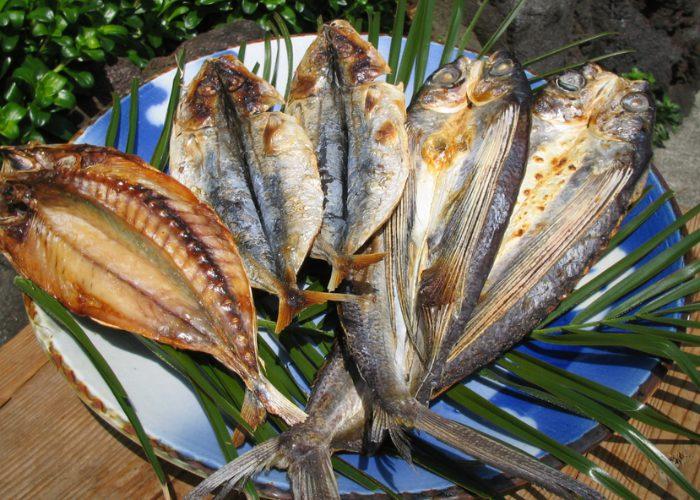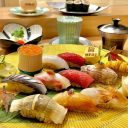
Of course, you already know about sushi, ramen and green tea ice cream. Today I’m going to introduce you a Japanese snack that is a little more challenging. While sushi usually features raw fish, kusaya goes in a whole other direction. It’s dried fish.
臭い(kusai=stinks)” + “魚(sakana=fish)
Adding to the challenge is the name. It was originally called “kusai sakana” or stinky fish but centuries of saying it and the sounds blended together to give us kusaya. It probably didn’t help matters much that kusaya is usually eaten in specific circumstances.
Kusaya is a popular drinking snack so you can imagine drinkers a few sakes into a big night slurring their words a little. They say it pairs really well with sake, shochu and beer. There is now a new trend of drinking tequila while nibbling on it. In izakaya, or Japanese pubs, you’ll often see small plates of bite-sized pieces of kusaya, sitting next to the regulars’ drinks.
Remember when your mum and dad told you to eat the all fish on your plate? Japanese parents are exactly the same! Kusaya is high in DHA, an omega-3 fatty acid essential to a well-functioning brain. It’s also a source of taurine which lowers blood pressure and prevents heart attacks. It helps you recover from fatigue more quickly and it’s also very good for your liver and bones. Once you learn how it’s made, its other health benefits will become more obvious.
Although it’s eaten all over Japan, kusaya is a speciality of the Izu Islands, a group of islands about 100km south of Tokyo. Their isolation meant they had to be self-sufficient so when too many fish were caught, what could not be eaten fresh was preserved.
If only it was as simple as drying the fish with some salt, but in the Edo era, 1603 to 1868, very strict laws about salt use began. The Izu Islanders found ways to get around them and improved dried fish forever. They made kusaya-jiru, a kind of salt syrup made from boiled down seawater. After the spine and fins of the scaled and cleaned fish are removed, any traces of bloody flesh is also cut out. This is then soaked in the kusaya-jiru for anywhere from 8 to 20 hours. The fish is removed, and the salt syrup is washed off. Then it is laid out in the sun for a day or two until it is dry. Finally, it is safe to store.
Despite being marinated in sea salt brine for ages, it doesn’t taste very salty. It is actually lower in salt than many other types of dried fish. Another side effect of this newer preserving technique was the fact that kusaya lasts longer.
This is where it gets crazy. Because salt in the Edo era was considered so valuable, the leftover kusaya-jiru was reused, along with any bacteria that had grown in it. This bacteria adds to the stink of stinky fish but it also helps cure and ferment it in a healthy delicious way, further developing the umami flavours. Umami is the fifth flavour component that was discovered by the Japanese inventor of instant noodles. All the yummiest things are all high in umami flavours, like cheese, bacon, and Vegemite. You can add kusaya to that list.
Just like kombucha and sourdough, it’s full of probiotics so it helps you maintain healthy gut flora. This means it boosts your immune system! But you don’t just eat it for your health. It also helps the body process and eliminates alcohol. So you can safely drink more without damaging your liver and there’s less chance of getting a hangover.
In 1965, there was no doctor on Niijima, one of the Izu Islands. When people there got sick or got injured then, they drank Kusaya-jiru, the stinky fish marinade, or put drops of it on their injuries, and they say they were magically cured! Take it with a grain of salt, pun intended, but it does have lots of natural antibiotics which could theoretically beat infections.
The Fear Factor
If you’re now scared to try kusaya I have some good news for you. Like lots of other ultra-stinky foods I’ve encountered on my travels, such as Taiwan’s stinky tofu and Malaysia’s durian, the smell is much worse than the taste. That smell is described as being like an old kitchen sponge or the unwashed socks of a teen-aged boy. That puts off many Japanese kids and even some adults from trying it. As rank as it might whiff, kusaya tastes like fish bacon. Some people even think it tastes a bit like aged cheese. A fish-flavoured aged cheese.
Don’t feel obliged to drink alcohol when you tuck into little strips of this dried fish. Lots of restaurants serve it grilled with rice, miso soup and a cup of tea. But you still might feel that the best way to eat it for the first time is in an izakaya with some friends and a drink. Dare them, or just dare yourself, to live dangerously. Brave the stink to try it for yourself, knowing that it’s not only delicious but also ridiculously healthy. And if you can’t stand the taste you can always wash it away with some sake.
— Article From BACK LANE











